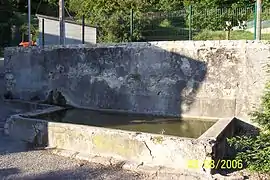Leychert
Leychert is a commune in the Ariège department in southwestern France.
Leychert | |
|---|---|
 The watering trough in Leychert | |
Location of Leychert | |
 Leychert  Leychert | |
| Coordinates: 42°56′43″N 1°43′48″E | |
| Country | France |
| Region | Occitania |
| Department | Ariège |
| Arrondissement | Pamiers |
| Canton | Pays d'Olmes |
| Intercommunality | Pays d'Olmes |
| Government | |
| • Mayor (2020–2026) | Martine Eynac[1] |
| Area 1 | 5.77 km2 (2.23 sq mi) |
| Population | 105 |
| • Density | 18/km2 (47/sq mi) |
| Time zone | UTC+01:00 (CET) |
| • Summer (DST) | UTC+02:00 (CEST) |
| INSEE/Postal code | 09166 /09300 |
| Elevation | 516–934 m (1,693–3,064 ft) (avg. 607 m or 1,991 ft) |
| 1 French Land Register data, which excludes lakes, ponds, glaciers > 1 km2 (0.386 sq mi or 247 acres) and river estuaries. | |
History
Etymology based on 2 assumptions: dry lake or forest cleared (comes from the name of the old domain "les eychartelles" which once included a forest)
The story depends Leychert until 1789 that of Roquefixade. Having belonged to the Count of Toulouse and the lord of Saint Paul Bernard Amiel de Pailhès, Leychert be included, since half of the 13th century, in the province of Languedoc, and not in the County of Foix (the limit being at In River, on the town's current Soula).
The village was part of the castellany Roquefixade (and Nalzen, Soula, Saint Cirac and river). It was in the King of France. The Lord of Those was the master of the late 17th century until the Revolution.
The church at Leychert was an annex of Roquefixade with a vicar. The church is dedicated to St. Anne, at least in 1633 (however, a church of Saint Pierre Leychert is regularly mentioned in the deeds of the 17th century). After years of disrepair, the church was restored in the mid-1990s and is classified as a historical monument.
Population
| Year | Pop. | ±% |
|---|---|---|
| 1962 | 69 | — |
| 1968 | 73 | +5.8% |
| 1975 | 49 | −32.9% |
| 1982 | 57 | +16.3% |
| 1990 | 65 | +14.0% |
| 1999 | 100 | +53.8% |
| 2008 | 107 | +7.0% |
See also
References
- "Répertoire national des élus: les maires". data.gouv.fr, Plateforme ouverte des données publiques françaises (in French). 9 August 2021.
- "Populations légales 2020". The National Institute of Statistics and Economic Studies. 29 December 2022.